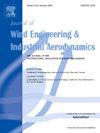考虑所有扭转-垂直频率比的柔性结构颤振速度实用公式
IF 4.2
2区 工程技术
Q1 ENGINEERING, CIVIL
Journal of Wind Engineering and Industrial Aerodynamics
Pub Date : 2025-03-17
DOI:10.1016/j.jweia.2025.106085
引用次数: 0
摘要
开发一个简单的预测颤振速度的公式一直是一个长期的目标,因为它的预测效率高,能够阐明关键的影响机制。尽管Selberg公式已被广泛应用,但其在接近垂直和扭转频率条件下的失效一直令人不安,特别是随着越来越多的工程结构表现出这一特征,例如,超长跨度桥梁,电缆支撑光伏系统和捆扎导体。在理论推导的基础上,提出了考虑结构阻尼的全频比范围颤振速度的简单实用公式,并通过数值算例验证了不同参数下颤振速度的有效性。该公式包括三个部分:两个类似于垂直分支颤振和扭转分支颤振的Selberg公式,以及一个分支切换颤振的最小颤振速度公式。给出了两种频率比公式来确定它们的边界,作为颤振类型识别的准则。最小颤振速度公式提供了整个频率比范围内的下限预测,为设计易发生颤振的结构提供了实用依据。在颤振分析中,阻尼因子公式可以方便地量化结构阻尼对颤振速度的放大效应和阻尼不确定性的影响。近频结构颤振速度对阻尼的敏感性远高于隔频结构。总结了具有不同颤振导数的结构截面在不同频率比范围内的颤振模式,以及预测颤振是否可能发生的准则。对于空气与结构质量比较大的情况,如索撑光伏系统,降低频率比是一种很有前途的颤振控制措施。对于基于颤振的能量收集系统,在高阻尼条件下颤振速度对频率比的敏感性较低;最小颤振速度的最佳频率比随等效阻尼和质量比的增大而增大。本文章由计算机程序翻译,如有差异,请以英文原文为准。
Practical flutter speed formulas for flexible structures considering all torsional-to-vertical frequency ratios
Developing a simple formula for predicting flutter speed has been a long-standing objective due to its high prediction efficiency and ability to clarify key influence mechanisms. Although Selberg's formula has been widely employed, its failure under close vertical and torsional frequency conditions has long been disturbing, especially as more engineering structures exhibit this feature, e.g., super-long-span bridges, cable-supported photovoltaic systems, and bundled conductors. Based on theoretical derivations, this study proposes simple practical formulas of flutter speed across the whole frequency ratio range and incorporates structural damping, with the validity examined through numerical examples under various parameters. The formulas comprise three parts: two formulas similar to Selberg's formula for vertical-branch flutter and torsional-branch flutter, and a minimum flutter speed formula for branch-switching flutter. Two frequency ratio formulas are provided to specify their boundaries, serving as the criteria of flutter type identification. The minimum flutter speed formula provides a lower-limit prediction across the whole frequency ratio range, making it practical for designing flutter-prone structures. The damping factor formulas enable easy quantification of both the amplification effect of structural damping on flutter speed and damping uncertainty impact in flutter analyses. The flutter speed sensitivity to damping of a close-frequency structure is much higher than that of a separated-frequency structure. Flutter patterns in different frequency ratio ranges are summarized for structural sections with various flutter derivatives, along with the criteria to predict whether flutter could occur. For the large air-to-structure mass ratio case, e.g., cable-supported photovoltaic systems, decreasing frequency ratio is a promising measure to control flutter. For the flutter-based energy harvesting system, the flutter speed is less sensitive to frequency ratio under high damping; the optimal frequency ratio for the lowest flutter speed increases with the equivalent damping and mass ratio.
求助全文
通过发布文献求助,成功后即可免费获取论文全文。
去求助
来源期刊
CiteScore
8.90
自引率
22.90%
发文量
306
审稿时长
4.4 months
期刊介绍:
The objective of the journal is to provide a means for the publication and interchange of information, on an international basis, on all those aspects of wind engineering that are included in the activities of the International Association for Wind Engineering http://www.iawe.org/. These are: social and economic impact of wind effects; wind characteristics and structure, local wind environments, wind loads and structural response, diffusion, pollutant dispersion and matter transport, wind effects on building heat loss and ventilation, wind effects on transport systems, aerodynamic aspects of wind energy generation, and codification of wind effects.
Papers on these subjects describing full-scale measurements, wind-tunnel simulation studies, computational or theoretical methods are published, as well as papers dealing with the development of techniques and apparatus for wind engineering experiments.

 求助内容:
求助内容: 应助结果提醒方式:
应助结果提醒方式:


